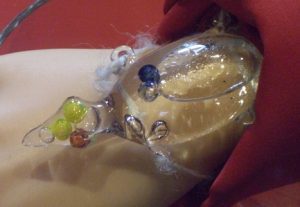Measuring with glass: "Toad" - German/German

The replica of this glass "turtle" was probably created as an examination paper at the glass school in Wertheim in the 1970s. The original was developed by Galileo Galilei at the University of Florence in the 17th century. The "toad" refers to more than 60 years of thermometer production in Wertheim. Thermometer glassblowers were the first glassblowers to settle in Wertheim in 1948 in the wake of the influx of refugees from Thuringia. Among them were the thermometer companies Arno Amarell and Karl Schneider, which still exist today.
The "toad" was intended to be tied to the arm of a feverish patient for measurement. This first known clinical thermometer is based on the physical principle that the density of liquids decreases as the temperature rises. This means that the buoyancy of the hollow glass spheres floating in the liquid decreases, so that they sink. So the higher the body temperature, the more balls sink to the bottom. If, in the case of the "toad", the fifth of the total of seven balls in the spirit of wine sinks, the patient has a fever.
Since the 1990s, this "toad" has been reminiscent of the "Galileo" thermometer in Celsius or Fahrenheit degrees, which was originally produced in Switzerland and later in Wertheim by the thousand. This was soon recognised as a bestseller by Chinese manufacturers.
Measuring with Glass: "Toad" - English

The reproduction of this glass toad possibly came from a Wertheim Technical College for Glasswork examination project during the 1970s. Galileo Galilei developed the original at the University of Florence during the 17th century. The "Toad," makes reference to the more than 60 years of thermometer production in Wertheim. Thermometer glassblowers were the first glassblowers to settle in Wertheim in 1948 in the course of the flow of refugees out of Thuringia. Among them were the thermometer companies Arno Amarell and Karl Schneider that still exist today.
The "Toad" was designed to be bound to a feverish patient's arm and was the first verifiable thermometer for measuring fever based on a principle of physics that the density of liquids decreases when temperature rises. This means the buoyancy of the hollow glass balls swimming in the liquid is reduced so that they sink. The higher the body temperature, the more the glass balls sink. If five of the altogether seven balls in the alcohol in the "toad," sink, the patient has a fever.
Since the 1990's the "toad" has enjoyed a revival in the form of the Celsius, or Fahrenheit "Galileo" thermometer, which was originally produced in Switzerland, but later in Wertheim. The Chinese were also quick to recognise its bestseller potential.